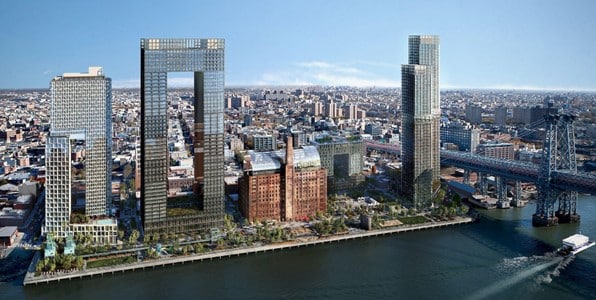Wind Tunnel Testing New York
Wind Engineering Studies at the Domino Site, Brooklyn
Windtech undertook comprehensive wind engineering studies for several buildings within the Domino Sugar Refinery site, employing cutting-edge techniques to overcome challenges and pave the way for a structurally resilient future. Here we discuss the intricate world of wind engineering and its pivotal role in shaping the urban landscape of Brooklyn.
Wind Engineering Methods Implemented
Windtech instrumented detailed models of the study buildings, which were set up in the wind tunnel within a proximity model of the surrounding Brooklyn region. Two proposed buildings involved linked substructures, which required Windtech’s advanced analysis technique to determine the most critical load cases accurately. A facade cladding pressure study was also conducted, providing accurate contours of maximum and minimum design pressures for New York’s 700-year recurrence interval. Windtech’s rigorous multi-sector analysis technique was able to account for wind directionality effects.
Challenges Faced During the Process
The primary challenge faced during the wind engineering study was the presence of linked substructures in two of the buildings. This necessitated the use of advanced analysis techniques to accurately determine the most critical load cases while accounting for the effect of the rigid linkages on the load transfer between the two substructures within each of these buildings.

Fig. 1 – Rendering of masterplan at the Domino Sugar Refinery site in Brooklyn, New York
Solution
Windtech’s skilled wind engineers utilised their expertise to overcome the challenges faced during the wind study. They did this using advanced analysis techniques to accurately determine the most critical load cases for the buildings with linked substructures. The envelope design loads from the various wind tunnel studies resulted in a significant reduction compared to the ASCE predictions, enabling the adoption of the minimum allowance of 80% of the ASCE loads for the design of the structure and façade. Windtech’s use of a rigorous multi-sector analysis technique to account for directionality contributed to this result.
Need help with an upcoming project? Don’t hesitate to contact our dedicated Global Wind Engineering team, who will gladly assist. With offices in Sydney & Melbourne, Australia, London, UK, and Mumbai, India. New York & Miami, USA, Dubai, Hong Kong & Singapore, we guarantee to support you wherever you are based.


